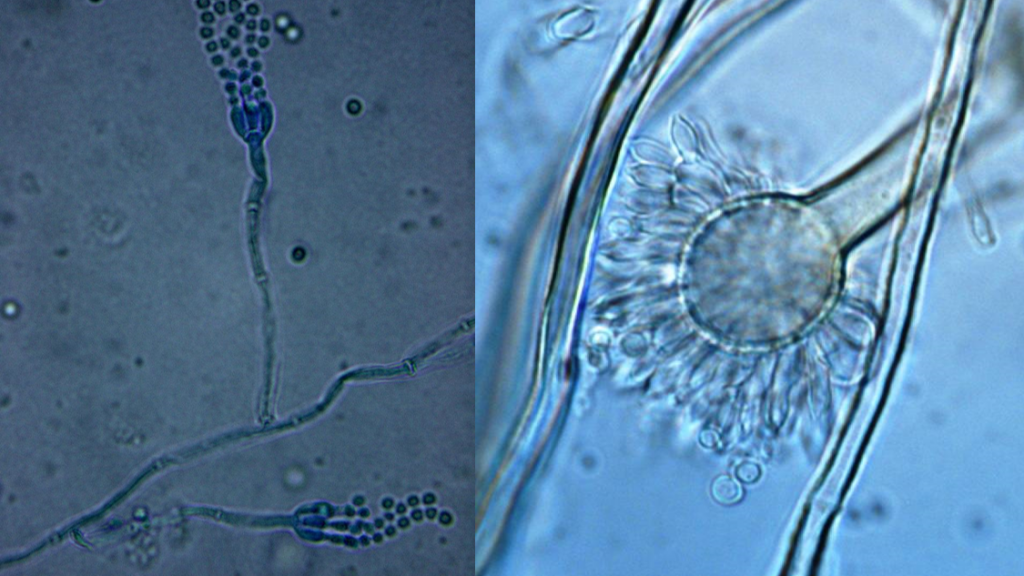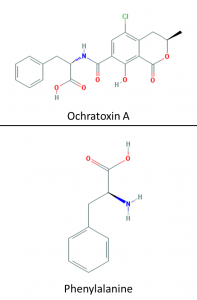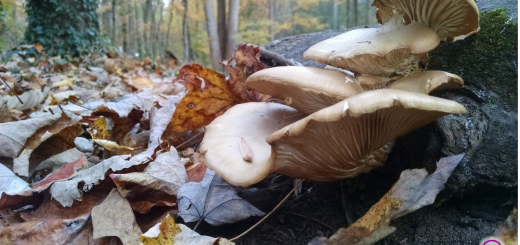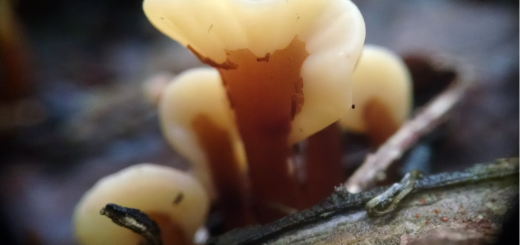#206: Ochratoxins

Ochratoxins are produced by a variety of species of Aspergillus and Penicillium. The left photo above shows a typical spore-producing structure of Penicillium, while the photo on the left shows a typical spore-producing structure of Aspergillus (A. ochraceus). Both genera contain molds that quickly grow on food products when conditions are right. Left photo by Dr. Sahay [CC BY-SA 3.0], via Wikimedia Commons. Right photo by James Baker (cepecity) [CC BY-SA 3.0] via Mushroom Observer.
Sources
Aspergillus and Penicillium are quintessential food molds; they quickly colonize plant products and decompose sugars and other readily available compounds. Consequently, they are among the first molds to appear on improperly stored food products. In general, these molds grow best when temperatures are at or above room temperature and there is a moderate amount of water available in the stored food.3,4
Different species are responsible for producing ochratoxins depending on the food involved. For cereal grains, the main culprit is P. verrucosum. In grapes and grape products, A. carbonarius contributes most to ochratoxin levels. Coffee, cocoa, nuts, and figs receive most of their ochratoxins from A. ochraceus, A. carbonarius, A niger, A. mellea, and less commonly by a few other Aspergillus species.1,3,5

The left side of ochratoxin A in the diagram above closely resembles the structure of the amino acid phenylalanine. This enables ochratoxin A to inhibit cellular machinery (such as protein synthesis) that uses phenylalanine. Photos by PubChem.
Structure and Mechanism
Penicillium and Aspergillus produce a few different types of ochratoxins, denoted A, B, and C. Ochratoxin A (OTA) is by far the most common and most toxic of this group.4 Ochratoxins are relatively small molecules, with a backbone composed of a double ring section attached to the amino acid phenylalanine.4,6
OTA primarily harms cells because of its similarity to phenylalanine, an amino acid that is essential for protein synthesis. Because of this similarity, OTA prevents an enzyme from attaching phenylalanine to tRNA. tRNA molecules are responsible for carrying amino acids (the building blocks of protiens) to the ribosomes (the areas where proteins are assembled). Without an adequate supply of tRNA-bound phenylalanine, protein production grinds to a halt. If it cannot produce any more proteins, the cell will eventually die. Additionally, OTA’s similarity to phenylalanine may also allow it to interfere with other cellular processes that require phenylalanine. Other types of ochratoxins are not nearly as toxic because they cannot interfere with the enzymes that bind phenylalanine and tRNA.7
Ochratoxins also cause DNA mutations in test cells, although the mechanism by which this happens is not known. Some studies have shown that ochratoxins can bind to DNA, which potentially damages the DNA strands.7 Whether this actually happens in living cells is unclear. Other researchers propose that ochratoxins cause widespread damage by increasing the amount of oxidative stress in a cell. This generalized damage could lead to mutations through a variety of mechanisms.1
Impacts
Ochratoxin A selectively accumulates in the kidneys, where it can cause severe damage at high doses. Most experimental animals are susceptible to OTA, although pigs are the only animals that have been observed to suffer from OTA-linked kidney damage outside of the lab.1,4 Pigs begin showing symptoms of kidney damage if they ingest 8μg of OTA per kilogram of body weight per day.1 If doses are exceptionally high, OTA can also cause liver damage.3 In mice and rats, long-term exposure to OTA causes kidney cancer.4 Although OTA has not been definitively linked to cancer in humans, the results in rodents led the International Agency for Research on Cancer to classify OTA as possibly carcinogenic to humans.1
The only human diseases linked to ochratoxins appear in the Balkan states and are Balkan endemic nephropathy and urinary tract tumors. However, another toxin – arstolochic acid – effects cells in the same way as OTA, so researchers can’t be sure which of the toxins is causing those diseases (if any).1,8 The European Union suggests that human exposure to OTA be limited to 120ng per kilogram of body weight per week. For Europe, that limit is easy to follow, since most Europeans are exposed to between 15 and 16ng OTA per kilogram of body weight per week.1
One of the greatest impacts of ochratoxins applies to international trade. When countries adopt regulations to protect their citizens from OTA exposure, it often becomes harder for other countries to export their goods. For example, many countries applied limits to OTA in coffee imports in the early 2000’s. This primarily impacted poorer countries and small farmers, who didn’t have the resources to comply with the new regulations. In this case, the Food and Agriculture Organization of the United Nations stepped in to help coffee exporting nations develop their abilities to reduce OTA contamination.9 Most countries currently do not regulate OTA, so similar situations could crop up in the future.10
Solutions
The Aspergillus and Penicillium molds responsible for ochratoxin formation are ubiquitous in the environment, so it is impossible to keep the fungi out of food entirely. The best way to prevent ochratoxin formation is to store agricultural products in conditions that discourage mold growth. Specifically, this means keeping stored food cool (less than 20°C) and dry (water activity less than 0.8).4,10
Do not use information in this post to self-diagnose or self-treat a medical complaint. Always consult a licensed medical doctor for proper diagnosis and treatment of a health issue.
See Further:
https://www.apsnet.org/edcenter/intropp/topics/Mycotoxins/Pages/Ochratoxins.aspx
https://www.romerlabs.com/en/knowledge-center/knowledge-library/articles/news/what-is-ochratoxin/
http://www.foodsafetywatch.org/factsheets/ochratoxins/
https://www.ncbi.nlm.nih.gov/pmc/articles/PMC3153213/
http://onlinelibrary.wiley.com/doi/10.2903/j.efsa.2006.365/epdf (long and detailed)
Citations
- European Food Safety Authority (EFSA). Opinion of the Scientific Panel on contaminants in the food chain [CONTAM] related to ochratoxin A in food. EFSA Journal 4, n/a-n/a (2006).
- Pfohl-Leszkowicz, A. & Manderville, R. A. Ochratoxin A: An overview on toxicity and carcinogenicity in animals and humans. Mol Nutr Food Res 51, 61–99 (2007).
- What is Ochratoxin? Romer Labs (2016). Available at: https://www.romerlabs.com/en/knowledge-center/knowledge-library/articles/news/what-is-ochratoxin/. (Accessed: 15th December 2017)
- Reddy, L. & Bhoola, K. Ochratoxins—Food Contaminants: Impact on Human Health. Toxins (Basel) 2, 771–779 (2010).
- Schmale III, D. G. & Munkvold, G. P. Mycotoxins in Crops: A Threat to Human and Domestic Animal Health: Ochratoxins. American Phytopathological Society Available at: https://www.apsnet.org/edcenter/intropp/topics/Mycotoxins/Pages/Ochratoxins.aspx. (Accessed: 15th December 2017)
- L-phenylalanine. PubChem Available at: https://pubchem.ncbi.nlm.nih.gov/compound/6140. (Accessed: 15th December 2017)
- Dirheimer, G. & Creppy, E. E. Mechanism of action of ochratoxin A. IARC Sci. Publ. 171–186 (1991).
- EFSA Panel on Contaminants in the Food Chain. Statement on recent scientific information on the toxicity of Ochratoxin A. EFSA Journal 8, n/a-n/a (2010).
- Ochratoxin A contamination in coffee. Food and Agriculture Organization of the United Nations Available at: http://www.fao.org/food/food-safety-quality/a-z-index/coffee/en/. (Accessed: 15th December 2017)
- Lawley, R. OCHRATOXINS : Food Safety Watch. Food Safety Watch (2013).
- Office of Regulatory Affairs. Water Activity (aw) in Foods. U.S. Food & Drug Administration (2015). Available at: https://www.fda.gov/ICECI/Inspections/InspectionGuides/InspectionTechnicalGuides/ucm072916.htm. (Accessed: 15th December 2017)









![#011: Characteristics of Kingdom Fungi [Archived]](https://www.fungusfactfriday.com/wp-content/themes/hueman/assets/front/img/thumb-small-empty.png)
